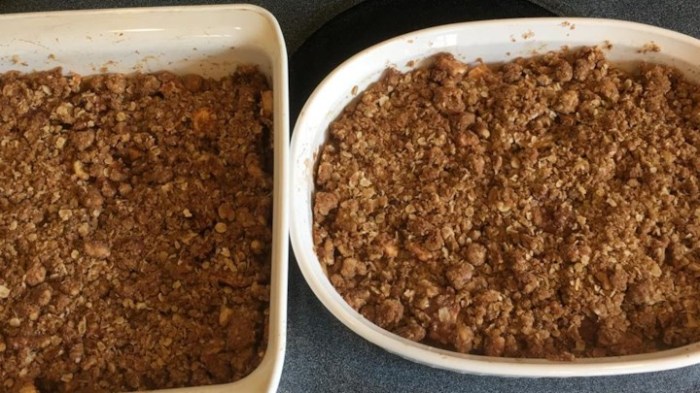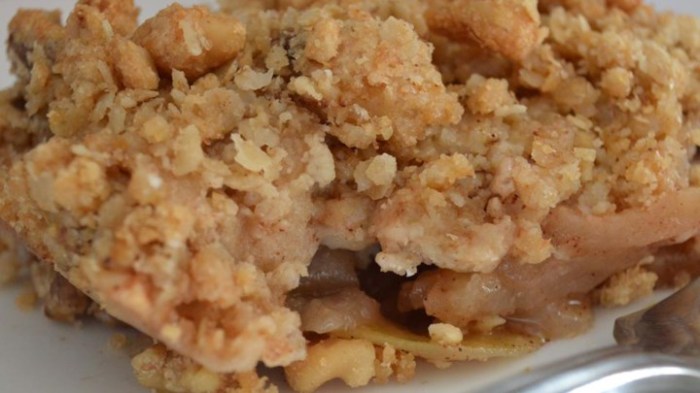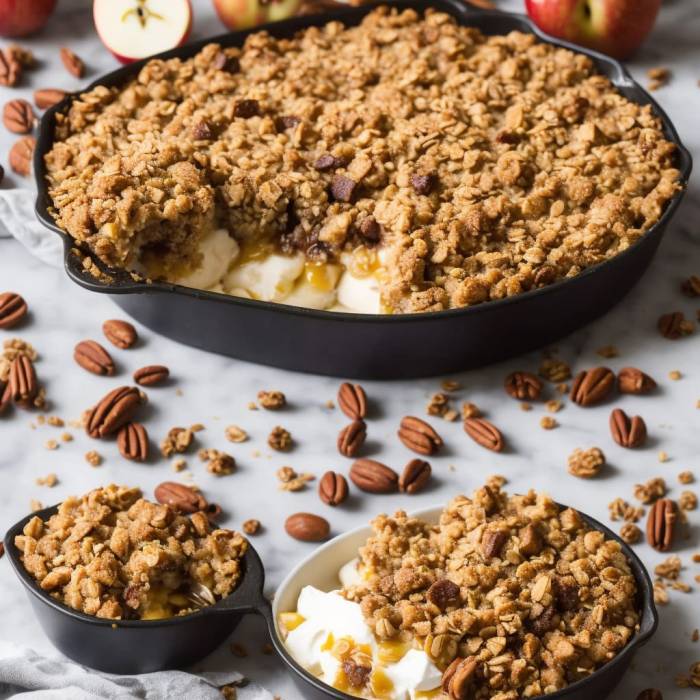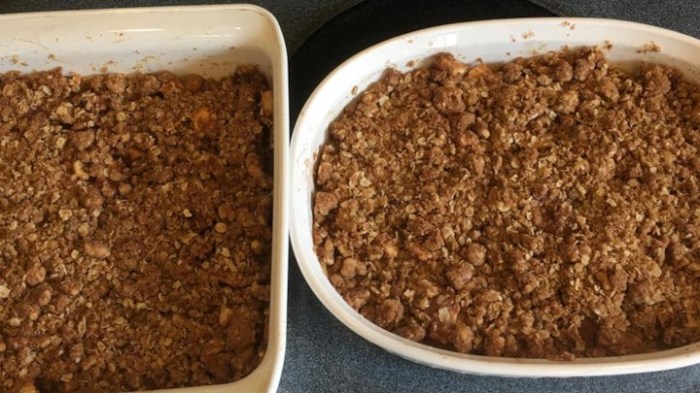
Healthier Apple Crisp II: A Sweet & Savory Twist
Healthier Apple Crisp II sets the stage for a delicious exploration of a beloved dessert with a nutritious twist. Forget the guilt-inducing sugar rush; we’re diving into a world of wholesome ingredients and satisfying flavors that will leave you wanting more.
This recipe isn’t just about replacing sugar with artificial sweeteners – it’s about embracing the natural sweetness of apples, the hearty goodness of whole grains, and the satisfying crunch of nuts and seeds.
We’ll delve into the heart of this recipe, uncovering the secrets to achieving that perfect balance of sweet, tart, and crunchy. From swapping out refined flour for whole grain alternatives to incorporating a medley of nuts and seeds for a boost of healthy fats and fiber, we’ll uncover the simple yet effective techniques that make this apple crisp truly “healthier.”
Recipe Variations
The beauty of apple crisp lies in its versatility. You can easily adapt the recipe to your preferences and dietary needs, exploring different flavor combinations, textures, and healthier ingredient swaps. This section will delve into several “healthier” variations, highlighting key differences between traditional and healthier recipes, focusing on ingredient swaps and cooking methods.
Healthier Ingredient Swaps
These variations aim to reduce sugar, saturated fat, and refined flour, while maintaining the deliciousness of apple crisp.
- Sweeteners:Traditional recipes often rely heavily on white sugar. Healthier alternatives include:
- Maple Syrup:Provides a richer, more complex flavor and contains natural antioxidants.
- Honey:Offers a slightly sweeter taste and is a good source of natural sugars and antioxidants.
- Agave Nectar:Has a mild, slightly floral flavor and a higher fructose content compared to other sweeteners.
- Dates:A natural sweetener with a caramel-like flavor and high fiber content. They can be blended into a paste for a smooth consistency.
- Flours:Traditional recipes use all-purpose flour. Healthier options include:
- Whole Wheat Flour:Adds fiber and nutrients to the crisp topping. It can be used in a 1:1 ratio with all-purpose flour, but it may result in a slightly denser topping.
- Oat Flour:Provides a slightly nutty flavor and a good source of fiber and protein. It can be used in a 1:1 ratio with all-purpose flour.
- Almond Flour:Adds a nutty flavor and is gluten-free. It is a good source of fiber and protein but may require slightly more liquid to achieve the desired consistency.
- Fats:Traditional recipes often use butter or shortening. Healthier options include:
- Olive Oil:Adds a healthy fat and a subtle, fruity flavor. It may require slightly more liquid to achieve the desired consistency.
- Coconut Oil:Offers a unique flavor and is a good source of medium-chain triglycerides. It is solid at room temperature but melts easily in the oven.
- Applesauce:Can be used as a substitute for some of the fat in the topping, adding moisture and sweetness.
Cooking Methods
Traditional apple crisp is often baked in the oven, resulting in a crispy topping and soft, caramelized apples. Healthier variations may use different cooking methods to enhance flavor and texture.
- Slow Cooker:This method requires less oven time and can create a more tender and flavorful crisp. The slow cooker’s gentle heat allows the apples to release their juices and create a rich sauce.
- Instant Pot:This method offers a quicker and more convenient way to cook apple crisp. The Instant Pot’s pressure cooking function helps to soften the apples and create a delicious sauce.
Nutritional Considerations

A healthier apple crisp can be a delicious and nutritious dessert option, offering a balance of flavors and textures while promoting good health. By making smart ingredient choices, you can enjoy a satisfying treat that’s lower in calories, fat, and sugar, and richer in fiber, vitamins, and minerals.
This weekend, I’m all about cozy fall flavors. My healthier apple crisp II is already in the oven, but I’m also thinking about whipping up a batch of that delicious no knead holiday pumpkin bread I found online. It’s the perfect complement to the crisp, and the aroma of cinnamon and pumpkin spice is just heavenly.
I can’t wait to share both with my family!
Comparing Nutritional Profiles
Let’s compare the nutritional profile of a traditional apple crisp with a healthier version.
- Traditional Apple Crisp:Typically made with refined white flour, butter, and white sugar, leading to a higher calorie and fat content. It may also be lacking in fiber and essential nutrients.
- Healthier Apple Crisp:Features whole grains, like oats or whole wheat flour, for increased fiber and complex carbohydrates. It often incorporates healthier fats, such as olive oil or coconut oil, and uses natural sweeteners like maple syrup or honey in moderation. This results in a lower calorie and fat content, while boosting the fiber and nutrient profile.
My healthier apple crisp II recipe is all about bringing that warm, comforting feeling of fall without the guilt. It’s a perfect balance of sweet and tart, and I love how it pairs with a scoop of vanilla ice cream.
But if you’re looking for something a little more decadent, you have to try this choc chip cheesecake dip recipe I found. It’s seriously amazing! Of course, a little indulgence is always good, but I’ll be sticking with my healthier apple crisp II for a guilt-free dessert most of the time.
Ingredient Substitutions and Their Impact
Ingredient substitutions play a crucial role in shaping the nutritional content of your apple crisp.
- Flour:Switching from refined white flour to whole grain options, like oats or whole wheat flour, increases the fiber content, promoting digestive health and providing a feeling of fullness. This also contributes to a lower glycemic index, which helps regulate blood sugar levels.
- Fat:Replacing butter with healthier fats like olive oil or coconut oil can lower saturated fat intake and provide beneficial fatty acids. Olive oil, rich in monounsaturated fats, may help lower cholesterol levels and reduce the risk of heart disease.
Coconut oil, containing medium-chain triglycerides, can provide a quick source of energy and may have potential benefits for metabolism and weight management.
- Sugar:Using natural sweeteners like maple syrup or honey in moderation can reduce added sugar intake. These sweeteners contain some nutrients, like antioxidants, and have a lower glycemic index compared to refined white sugar. However, it’s important to consume them in moderation as they still contribute to calorie intake.
Benefits of Whole Grains, Nuts, and Seeds
Incorporating whole grains, nuts, and seeds into your apple crisp offers numerous nutritional benefits.
- Whole Grains:Rich in fiber, B vitamins, and minerals like magnesium, they contribute to digestive health, energy production, and nerve function.
- Nuts:Packed with healthy fats, protein, fiber, and vitamins, they provide sustained energy, support heart health, and promote satiety.
- Seeds:Excellent sources of fiber, omega-3 fatty acids, and antioxidants, they contribute to digestive health, brain function, and overall well-being.
Cooking Techniques

Preparing a healthier apple crisp involves a few key techniques that ensure optimal texture and flavor. This section explores the steps involved, provides tips for choosing and preparing apples, and discusses alternative cooking methods.
Apple Selection and Preparation
Choosing the right apples is crucial for a delicious apple crisp. Opt for apples with a balance of sweetness and tartness, as they will provide the best flavor profile.
- Recommended Apple Varieties:Granny Smith, Honeycrisp, Braeburn, Fuji, Pink Lady, and Golden Delicious are excellent choices for apple crisps. These varieties hold their shape well during baking and offer a good balance of sweetness and tartness.
- Preparing Apples:Once you’ve chosen your apples, peel, core, and slice them into uniform pieces. The size of the slices will influence the cooking time, so aim for slices that are about ¼ inch thick.
- Enhancing Apple Flavor:To enhance the natural sweetness of the apples, you can toss them with a squeeze of lemon juice. This will help prevent browning and add a subtle citrusy note.
Cooking Methods
Baking is the most common method for preparing apple crisp, but other techniques can be used to achieve different textures and flavors.
- Baking:Baking in the oven at 375°F (190°C) for about 30-40 minutes results in a crisp topping and tender apples. The oven’s even heat allows for consistent cooking and a golden-brown topping.
- Broiling:Broiling offers a faster cooking time and a more caramelized topping. However, it requires close monitoring to prevent burning. Broil the apple crisp for 5-10 minutes, or until the topping is golden brown and bubbly.
- Slow Cooking:Slow cooking provides a gentle and even heat, resulting in tender apples and a soft topping. Cook the apple crisp on low heat for 4-6 hours, or until the apples are tender and the topping is heated through.
Topping Techniques
The topping is an essential part of any apple crisp. A healthier version can be achieved by using less butter and sugar and incorporating whole grains.
- Oat-Based Topping:A classic oat-based topping provides a satisfying crunch and a slightly sweet flavor. Combine rolled oats, whole wheat flour, brown sugar, and a small amount of melted butter or oil.
- Nut-Based Topping:For a nutty twist, incorporate chopped nuts like almonds, pecans, or walnuts into the topping. These nuts add a healthy source of fats and protein.
- Spiced Topping:Enhance the flavor of the topping with warm spices like cinnamon, nutmeg, or ginger. These spices complement the sweetness of the apples and create a comforting aroma.
Visual Presentation: Healthier Apple Crisp Ii

A visually appealing presentation can enhance the appeal of your healthier apple crisp. By incorporating tables, diagrams, and visual guides, you can effectively convey the nutritional benefits and demonstrate the ease of preparation.
Nutritional Comparison
This table compares the nutritional values of a traditional apple crisp and a healthier version, highlighting the differences in calories, sugar, and fat content.
| Nutrient | Traditional Apple Crisp | Healthier Apple Crisp |
|---|---|---|
| Calories | 300-400 | 200-250 |
| Sugar | 30-40 grams | 15-20 grams |
| Fat | 15-20 grams | 5-10 grams |
Step-by-Step Preparation, Healthier apple crisp ii
This visual guide Artikels the steps involved in preparing a healthier apple crisp. Each step is accompanied by a brief description, making the process easy to follow.
- Step 1: Prepare the Apples– Wash, peel, and slice the apples. You can use a variety of apples, such as Granny Smith, Honeycrisp, or Fuji.
- Step 2: Combine the Ingredients– In a large bowl, combine the sliced apples with cinnamon, nutmeg, and a small amount of sweetener.
- Step 3: Prepare the Crumble Topping– In a separate bowl, combine rolled oats, whole wheat flour, and a small amount of sweetener. Use a fork or your fingers to mix the ingredients.
- Step 4: Assemble the Crisp– Pour the apple mixture into a baking dish. Sprinkle the crumble topping evenly over the apples.
- Step 5: Bake– Bake the apple crisp in a preheated oven at 375 degrees Fahrenheit for 30-40 minutes, or until the topping is golden brown and the apples are tender.
- Step 6: Serve– Let the apple crisp cool slightly before serving. You can add a scoop of vanilla ice cream or a dollop of whipped cream for an extra treat.
Topping Variations
This visual guide showcases different variations of healthier apple crisp toppings, highlighting their nutritional benefits. Each topping is described along with its nutritional advantages.
- Oatmeal Crumble– This classic topping is made with rolled oats, whole wheat flour, and a small amount of sweetener. Oats are a good source of fiber, which can help regulate blood sugar levels and promote digestive health.
- Nut Crumble– For a boost of protein and healthy fats, try a nut crumble topping. Use a mixture of chopped walnuts, almonds, and pecans. Nuts are also a good source of fiber, vitamins, and minerals.
- Seed Topping– A seed topping is a great way to add a crunchy texture and a boost of nutrients. Use a mixture of chia seeds, flaxseeds, and sunflower seeds. Seeds are rich in omega-3 fatty acids, which are beneficial for heart health.

